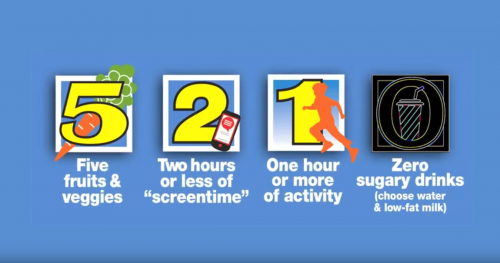Inspiring a community-wide culture of health
Takeaways
- Community health needs indicators showed extremely high rates of obesity in Logan County, Ill.— 30.4 percent of adults are obese, a 19.5 percent increase since 2001.
- Abraham Lincoln Memorial Hospital facilitated three innovative projects focused on improving healthy food access and physical education
- Coordinated Approach to Child Health program
- 5210 marketing and activities campaign
- Abraham Lincoln Memorial Hospital Farmers Market
- In the 2016 county-wide survey of youth, Logan County reported a decrease in body mass index (BMI) across 8th, 10th, and 12th graders compared to 2014. Among the same population, fruit consumption increased by 10 percent from 2014 to 2016.
- Hospital Type: Nonprofit, critical access facility
- Hospital Size: Small (25 beds)
- Geographic area: Rural
- System/Network: Memorial Health System of Springfield--includes four hospitals, mental health centers, physician services, and home services.
- Network coverage: Central Illinois
- White: 89.7%
- African American: 7.9%
- Asian: 0.7%
- Hispanic: 3.3%
- CHNA community: Logan County and eastern Mason County
- Population: 30,305
- Adult obesity: 30.4%
- Adults with diabetes: 9.9%
- Persons living below poverty line: 13.8%
- Hyperlipidemia in Medicare population: 51.5%
Abraham Lincoln Memorial Hospital (ALMH) lies just off historic Route 66 in the northwest corner of Lincoln, a small town in central Illinois. Beyond the hospital, much of the town is planted with endless fields of soy and corn. Together with mining, agriculture and its related industries account for most of the employment in Logan County, for which Lincoln is the county seat.
With its picturesque main street appeal and a population of 14,000, Lincoln embodies a typical rural, midwestern town. In this small town, the banners advertising healthy eating that cover the courthouse square are hard to miss. In fact, ALMH is responsible for the many advertisements, banners, and posters that encourage residents to eat healthily and engage in physical activity. Playing jingles on the local radio and placing commercials before summer box-office hit movies in the local theater are some of the ways that ALMH has tried to “inspire a culture of health,” among local residents. These marketing strategies are part of a larger strategy to reduce high obesity rates in the county.
Community health needs assessment: Priorities and process
- Food and diet-related disease priorities:
- 2012 CHNA - Cardiovascular disease, diabetes, and obesity
- 2016 CHNA - Obesity
- Participation from food-based organizations in CHNA process: Women, Infants, and Children (WIC) and Community Action Partnership of Central Illinois (an anti-poverty organization that manages the local food pantry)
- How/why did food issues emerge as a priority?
- There was compelling, alarming data gathered during the CHNA process that propelled obesity to the top of community needs priorities. Among this was data from the Healthy People 2020 Report and local and state data.
- Key community indicators:
- 30.4% of Logan County adults are obese.
- From 2005 to 2008, 33.9% Logan County residents over age 20 were obese.
- The percentage of obese, low-income preschool children increased from 13.4% in 2008 to 15.4% in 2011.
Full assessment: 2015-2018 Abraham Lincoln Memorial Hospital Community Health Needs Assessment.
Assessing health needs — and how to meet them
Community health needs assessment process
For the 2015 community health needs assessment (CHNA), Memorial Health Systems (Abraham Lincoln Memorial Hospital is an affiliated hospital) contracted with Healthy Communities Institute, a Berkeley, California-based organization that provides data and analytic tools on population health and social indicators. The Healthy Communities Institute provided a custom dashboard to Memorial Health Systems, which included local and national data sets on indicators for each county in their service area. The data showed extremely high rates of obesity—30.4 percent of adults in Logan County were obese, a 19.5 percent increase since 2001. This data laid the foundation for the needs assessment and the determination of community priorities.
Abraham Lincoln Memorial Hospital also worked closely with the Logan County Department of Public Health to develop their 2015 CHNA. While in previous years, the two supported one another’s assessment processes, 2015 was the first year the department and ALMH coordinated their processes and timelines. Although each developed a unique assessment, both used the same data sets, identified the same priorities, and aligned implementation strategies.
For Angela Stoltzenburg, ALMH marketing and community partnerships director, this collaborative process was a way for the department of public health and the hospital to strategically leverage their investments and resources on implementation.
— Angela Stoltzenburg, Abraham Lincoln Memorial Hospital marketing and community partnerships director
Obesity, along with chronic disease management, mental health, and access to health care, emerged as community priorities.
To help them review data and prioritize community needs, ALMH relied on the input and expertise from members of the ALMH Community Health Collaborative, a 20-year-old community health coalition that includes representatives from across the community including: WIC, as well as education and local service providers. This coalition was central to the CHNA process and provided not only insight that helped the community benefit team interpret data, but also strengthened partnerships to implement the hospital’s vision of creating a culture of health.
“You have to have the right stakeholders at the table to collaborate on community issues. It’s important to be able to leverage each other’s resources, but it’s also the best way to present a consistent message. When you are trying to create a culture of health, you need everyone to be on board with that vision and message. When our partners take that vision and apply it to their work, it creates a community-wide effort with a focused game plan,” said Stoltzenburg.
Investing in solutions
Implementation strategy
For their implementation strategy, the community benefit team led a comprehensive search for evidence-based interventions that could be expanded or replicated at Abraham Lincoln Memorial Hospital. To identify potential interventions, Angela Stoltzenburg reviewed online case studies from Robert Wood Johnson Foundation, researched the work of organizations that received awards or were recognized for their obesity prevention work, and looked into the efforts of local and state organizations such as the Illinois Alliance to Prevent Obesity. This research helped expose Stoltzenburg to what other groups were doing and helped her team identify obesity interventions that could have an impact on the residents of a small, rural Illinois town.
Stoltzenburg understands that an implementation strategy must not only be a good fit (replicable, realistic, and economically viable) for the community; it must also garner support from hospital leadership and decision-makers. In addition to sifting through and carefully researching hundreds of potential interventions, Stoltzenburg and her team also had to get the buy-in of the Abraham Lincoln Memorial Hospital Foundation. The foundation works with community benefit to fund interventions.
Ultimately, an implementation strategy is a delicate negotiation between stakeholders from the community and within the hospital itself that must be carefully navigated by community benefit directors to find the best fit.
In addition to supporting physical activity interventions (a 5K girls’ run and outdoor trails) and breastfeeding encouragement programs, ALMH funds three programs under the obesity priority: Coordinated Approach to Child Health (CATCH), a farmers market, and the 5210 program.
Coordinated Approach to Child Health (CATCH) Program
The CATCH Program is a school-based program that teaches children to identify healthy foods and to increase their physical activity. Fifteen out of 16 schools in Logan County participate in the program
- Program type: Health and nutrition education
- Program administrator: Abraham Lincoln Memorial Hospital
- Program founded: 2014
- Hospital role: Provide grant support; provide staff or financial support for program evaluation; manage or coordinate a program or community collaboration
- Community partners: Local schools and YMCA centers
- Population served: All children in participating schools (15 schools) learn the CATCH curriculum. The goal is to have 100 percent of schools in the ALMH service area participate
- Program goals: To teach children to identify healthy foods and to increase physical activity
- Health needs addressed: Obesity
- Key outcomes: 3,000 students are enrolled in CATCH schools in the hospital’s service area. The program has been observed to help students making healthier choices regarding food and activity.
Program Description
The CATCH program was developed as a way to improve child health in the late 1980s through a collaborative effort by the University of California at San Diego, University of Minnesota, Tulane University and The University of Texas-School of Public Health. The program has been implemented in over 10,000 schools across the United States and has been demonstrated to help decrease childhood obesity by 11 percent. The CATCH program is based on a curriculum that includes nutrition education activities, physical education equipment, and messaging for educators to engage children. Messaging is aimed at children while they are in physical education class, the lunchroom, classroom, and at home. The goal of the program is to implement health education in both school and home settings in order to achieve a comprehensive, community-wide effort to support youth to develop healthy lifestyle habits.
In the ALMH service area, 15 of 16 preK-12 schools have signed on to participate. This number is up from eight participating schools in 2015. In 2017, the CATCH program focused on early childhood engagement and enrolled three new early childhood schools (Head Start and preschools) to the program.
Abraham Lincoln Memorial Hospital supports CATCH activities at participating schools during the 6-week program. For example, one student’s favorite activity is the CATCH Smoothie Bike: a bike-powered blender that students pedal to make healthy smoothies. The hospital also hosted a “CATCH me if you can” race for students that featured color bombs and activities.
Partnership, financing, and hospital role
The foundation provides funding for CATCH, which includes one part-time staff member to coordinate and train schools on the CATCH curriculum. The coordinator also facilitates meetings for CATCH educators. In 2016, the hospital contributed $35,000 for curriculum materials, such as photocopies of activities for students and parents, physical education equipment (such as hula hoops), and snacks for school CATCH activities. The hospital also funded and hosted a CATCH workshop, which featured a national trainer.
For Stoltzenburg, the CATCH program offers a promising opportunity to engage children at a critical moment in their lives. In Logan County, there is a sharp increase in obesity rates as students enter high school, a rate Stoltzenburg hopes the CATCH program can help decrease.
“It's all happening in high school, so we want to see kids get through the CATCH program,” she said, “and see them reporting more intake of fruits and vegetables at these young ages before we see an increase in BMIs in high school."
Evaluation methods
The CATCH program is in its third year and uses annual staff surveys and the Illinois Youth Survey to track student outcomes. The evaluation includes tracking fruit and vegetable consumption and body mass index (BMI). The data is still insufficient to track community-level changes, but the long-term goal is to reduce obesity rates in the county.
Findings from the 2015-2016 survey include:
- 100 percent of school staff in participating schools reported students using CATCH language
- 90 percent of staff believe students are learning to make healthier choices regarding nutrition and activity because of CATCH
- 100 percent of school staff want to continue to use the program.
Lessons learned
A major takeaway for ALMH was the importance of creating consistent messaging throughout the community. “We are creating a culture of health by spreading the messaging everywhere we can, while keeping the messaging consistent,” said Stoltzenburg. “We worked with school partners, but we spread it beyond schools. For example, residents see CATCH messaging on local transit, billboards, and at community events.”
While it is difficult to track direct impacts, the repetition of consistent, clear messaging for students and parents may have much to do with increased fruit and vegetable consumption and reduced BMI the county observed in its last youth survey.
5210 Program
The 5210 program is a campaign that brings awareness to healthy eating and lifestyle habits through messaging to children and families. The campaign has been implemented in the Abraham Lincoln Memorial Hospital community through billboards, ads, posters, and through creative contests that engage children in spreading the 5210 message.
- Program type: Health campaign
- Program administrator: Abraham Lincoln Memorial Hospital
- Program founded: 2014
- Hospital role: Provide grant support
- Community partners: Local schools and 5th-grade classes for competitions
- Population served: Community-wide campaign with a focus on school-aged children
- Program goals: To improve healthy eating education and increase physical activity
- Health needs addressed: Obesity
- Key outcomes: 2016 Illinois Youth Survey reported a decrease in BMI across 8th, 10th, and 12th graders compared to 2014. Among the same population, fruit consumption increased by 10 percent from 2014.
Program Description
5210 is a component of the Let’s Go program developed at Barbara Bush Children's Hospital in Maine. This educational campaign promotes obesity prevention by encouraging daily healthy behaviors including eating 5 fruits or vegetables every day, having no more than 2 hours of screen time, doing at least 1 hour of physical activity, and consuming 0 sugar-sweetened beverages.
Abraham Lincoln Memorial Hospital incorporated the 5210 program as a key part of its implementation strategy to “inspire a culture of health” in the community. They refashioned the campaign to give it a local look and feel and incorporated it into places where Logan County families live, learn, work, and play. These include: billboards, banners in public spaces, print ads in local media, placing posters in schools, social media, local radio ads, and community events. The goal was to incorporate consistent 5210 messaging onto various platforms to expose residents, particularly children, to the 5210 daily health habits.

Partnership and hospital role
Abraham Lincoln Memorial Hospital provides community benefit staff time to implement and manage the program, which is primarily marketing and communications. The hospital developed strong partnerships with local schools and provided extra outreach to 5th-grade classes to engage students in the campaign.
The community benefit team came up with creative, fun ways to get children excited about participating in the campaign. For example, they held a contest with 5th-grade classes competing against each other to sing the 5210 jingle. The winning class got to make their very own rockstar video which was featured at the local movie theater before every movie screening the entire summer.
In 2015, the hospital also hosted a “selfie contest” where 5th graders submitted selfies of themselves engaging in healthy habits. These photos were compiled in a commercial that also ran in the local theater.
Financing
Abraham Lincoln Memorial Hospital funded the creation of the marketing materials, advertisements, contests, and commercials.
Evaluation Methods
In addition to placing billboards and banners across the county, the campaign has been implemented in 90 percent of Logan County schools. There are no evaluation components to track student engagement, but ALMH monitors impacts through county-level changes in BMI and fruit and vegetable consumption through the Illinois Youth Survey, a county-wide survey of youth.
In the 2016 Illinois Youth Survey, Logan County reported a decrease in BMI across 8th, 10th, and 12th graders compared to 2014. Among the same population, fruit consumption increased by 10 percent from 2014.
Lessons learned
Like many community benefit directors, Stoltzenburg wears many hats in the hospital. In addition to directing community benefit assessments and strategies, she also manages the hospital’s internal and external communications. “It's hard to be really great at everything,” she said.
Often, program evaluation is difficult to balance in addition to juggling multiple duties, especially since the outcomes of a certain program can be difficult to track or have long timelines that can’t always be captured in a community benefit reporting.
“It would certainly be nice if a measurement outcome could be handed to me on a silver platter … It would make it so much easier to be able to prove that it's working or it's not,” said Stoltzenburg.
Abraham Lincoln Memorial Hospital Farmers Market
Abraham Lincoln Memorial Hospital supported the founding of a hospital farmers market, an indoor, producer-only market in Logan County. In addition to managing the market, the hospital hosts activities including free health screenings, Power of Produce Kids Club, and fitness classes.
- Program type: Farmers market
- Program administrator: Abraham Lincoln Memorial Hospital
- Program founded: 2015
- Hospital role: Provide grant support; provide staff or financial support for program evaluation; manage or coordinate a program or community collaboration
- Community partners: Logan County Fairgrounds, local vendors, and producers
- Population served: Open to the public
- Program goals: Increase access to fruits and vegetables
- Health needs addressed: Obesity
- Key outcomes: In 2017, the market had 13,300 visitors who spent over $48,000 in local produce. The market provided 500 free health screenings and gave away $1,600 in tokens to children participating in the Power of Produce Club.
Shoppers at the Abraham Lincoln Memorial Hospital Farmers Market in Illinois, an indoor, producer-only hospital-sponsored and supported market featuring local products (Abraham Lincoln Memorial Hospital).
Program Description
The Abraham Lincoln Farmers Market is an indoor market that features homegrown, handmade, and vendor-created goods and produce from the state of Illinois. It is located at the Logan County Fairgrounds across the street from ALMH, which is a low-food access, low-income area. The market is open Saturday mornings, May through September.
Partnership and hospital role
Abraham Lincoln Memorial Hospital supports activities at the market including free monthly health screenings, cooking classes, and the Power of Produce Club (POP Club). The club provides weekly healthy eating activities for children in grades K-12. Each week they participate, children receive a check mark on their POP passport which earns them two dollars worth of farmers market tokens that can be used to buy fresh fruits and vegetables. The hospital provides marketing support to promote the market and POP Club in local schools and through social media.
Financing
Abraham Lincoln Memorial Hospital community benefit funds staff time for clinicians to conduct monthly health screenings at the market and the ALMH Foundation funds a part-time market coordinator. The hospital also provides meeting space for market coordination and vendor meetings. The hospital foundation (not community benefit) provided the bulk of the $100,000 needed to launch the market including funds for renovating the fairgrounds and materials such as vendor backdrops and signs.
Evaluation methods
Abraham Lincoln Memorial Hospital hired a consultant to evaluate the market. The market coordinator and volunteers help collect evaluation measurements. In its inaugural year, the market had approximately 13,000 visitors who purchased over $32,000 in local produce. In 2017, the market hosted 13,268 visitors who spent over $48,000 dollars on produce.
In 2017, nearly 500 free health screenings were conducted. Over 800 POP activities were hosted and children earned over $1,600 in market tokens for produce.
In its first year, the market struggled to attract low-income community members (based on Supplemental Nutrition Assistance Program [SNAP] usage rates at market), which left double match dollars unused. That first year, only $992 SNAP dollars were spent with a $370 match. In 2017, the program increased SNAP use to $1,308 with a $992 match.
Lessons learned
While the market was a success for the hospital and community, Stoltzenburg acknowledged that the market struggled during its first year to engage lower-income residents.
“We did not do a good enough job reaching out to the low-income population ... We need to do a better job reaching out so they know that it's an option, an opportunity." The hospital set a goal for improving the SNAP match program and increasing SNAP usage and in 2017, Stoltzenburg worked hard to meet this goal.
Abraham Lincoln Memorial Hospital worked with local transit to provide free rides to the market (though only a few people used the service). The most successful efforts ALMH invested in were extensive advertising and personal community outreach. Stoltzenburg, herself, walked door-to-door in the low-income neighborhoods surrounding the market, handed out materials, and spoke with residents about the activities and incentives the market offered, including the POP club and SNAP match. She also ensured that all collateral and materials for the market prominently and consistently advertised the SNAP match. The outreach and advertising paid off—in 2017, the market saw a 32 percent increase in SNAP usage from the previous year.
Abraham Lincoln Memorial Hospital chose to deliver interventions to their community that leveraged the core strengths of the community benefit staff members namely marketing and communications. Blending the unique expertise of Stoltzenburg’s marketing skills and knowledge of community health, ALMH was able to build a community-wide culture of health that would not have been possible without the strong campaigns the hospital developed and pushed into their region.
Their focused, strategic messaging was also, importantly, a community-wide effort backed by schools, physicians, and partner organizations. Although changing behavior is extremely difficult, the results are promising. Already, county-level data is indicating some change is afoot in Lincoln and the surrounding areas, which have seen reduced BMIs and increased fruit and vegetable consumption. The hope for ALMH and their dedicated community benefit staff members, is that these positive changes continue to develop and that students exposed to the healthy food campaigns take these behaviors with them as they enter adulthood.
![The Abraham Lincoln Memorial Hospital Smoothie Bike features a pedal-powered blender that students pedal to make healthy snacks as part of the Coordinated Approach to Child Health (CATCH) program activities. [Abraham Lincoln Memorial Hospital]](/sites/default/files/styles/banner_large/public/images/CATCH%20Smoothie%20Bike_cropped.jpg?itok=ZktWDAlV)








